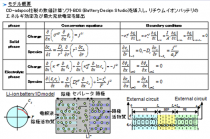Technology that uses numerical calculation to elucidate the internal transport mechanism inside lithium ion batteries

- researcher's name
- affiliation
- research field
-
Thermal engineering
- keyword
-
background
While lithium ion batteries for vehicles hold promise for the high energy density and output density, heat management is a problem for batteries under harsh usage conditions. Hence, by coupling the energy equation and the governing equation for internal transport, and conducting numerical calculation to analyze the mechanism of the battery’s internal transport phenomenon, abnormal heat generation can be elucidated and quality improved.
summary
Using a lithium ion battery for HEV (hybrid electric vehicle), designed using a general-purpose numerical calculation software program BDS (Battery Design Studio), simulations of “constant current experiments on actual equipment” can be implemented. From the charge/discharge curve, a basic property obtained by simulation, the battery’s performance is efficiently and simply expressed, and they can be introduced into HEV simulators.
application/development
Even in comparison with experimental data from actual equipment, a sufficient level of accuracy is obtained, so using the simulation, it is possible to design various kinds of lithium ion batteries with improved heat management capacity. Doing so allows the development of lithium ion batteries with lowered prototyping costs and improved durability, safety and life cycle.
predominance
Due to the fact that the battery properties are reproduced by solving the partial differential equation that governs the lithium ion transport mechanism inside the battery rather than by obtaining them through actual equipment-based experiments, it is also possible to analyze the internal phenomena that cannot be predicted by experiment. Therefore, it is possible to acquire the key parameters involved in abnormal heating and obtain effective design guidelines for heat management of the battery.
purpose of providing seeds
Sponsord research, Collaboration research
material
posted:
2014/05/21




